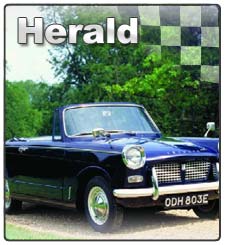Triumph Herald Vehicle Information

It was 1956 when work first started on project Zobo which later became the Herald we all know, love and drive today. However if the chairman of BMC Sir Leonard Lord had not had a disagreement with the MD of Standard-Triumph Alick Dick, then Zobo may have turned into a completely different car. Standard -Triumph had hoped to renew a long term contract with a subsidiary of BMC for building bodies of the yet to be announced new model. However due to the rebuff and a lack of capacity at the other body building company Pressed Steel Co, a major rethink was required. Standard-Triumph did not want to be beholden to outside contractors for monocoques and a lack of in house pressing capacity, the decision was made to go down the separate chassis route. Although at the time it was seen as a retrograde step compared to the monocoque construction now being used by all the other major manufacturers, it did however offer several advantages.
Firstly it enabled Triumph to manufacture the body panels in smaller sections and thus gave a greater choice of smaller scale suppliers. It obviated the need for assembly jigs, and finally, and probably most importantly, it enabled various body styles to be easily produced with the minimum of modification.
If the styling had been left to Triumphs own internal stylists, we would never have had the benefit of the stylish bodywork that graces the Herald. In fact when project Zobo was initiated in 1956 the in house initial designs were dumpy to say the least. Some people even went as far to say that it resembled a mechanical bathtub on wheels. It needed a styling miracle, and that miracle came along in the spring of 1957 when the Standard-Triumph management team were introduced to Giovanni Michelotti. Michelotti delivered the prototype on Christmas Eve 1957. Apart from a few details like bonnet latches, tail lamps, grille and badging, what he delivered was identical to how the coupé version of the Herald looks today. The Zobo prototype X608 and other pre production prototypes were put through a variety of testing including a trip to Tangier.
The Herald was launched in 1959 at the Albert Hall by Bob Monkhouse. The coupé and saloon models were displayed and, as a unique piece of theatrical display, a team of mechanics built up a car from sub assemblies in four minutes, after which it was started and driven away. At the launch the coupé cost £731 and the less powerful saloon came in at £702 including purchase tax. Sales were initially good with a high level of interest from the motoring press. Unfortunately the Herald was more expensive than the competition (a Ford Anglia 105E was £92 less and you could buy a Morgan 4/4 for the same price as the Herald). With the financial problems of the time, it was not good news. Normally Triumph reacted to falling sales by dropping prices, however instead as they had just been taken over by British Leyland, they launched a stripped out version called the Herald S which was sold at £664.
From this start a whole range of models were produced; 948, S, 1200, Courier van,12/50 & 13/60 in a variety of body styles. (Coupé, saloon, convertible and estate). A total of 521902 cars were sold. Together with all the models based on this original chassis design, the Vitesse, Spitfire, GT6 and Bond ranges gave a total just short of a million cars.
Vehicle Production & Specification Summary
| Model |
Production Dates |
Total Built |
Commission Numbers |
| 948 & Herald S |
March 1959 to June 1961
(Jan 1964 for Herald S) |
76860 |
G1 to G66994
(G73751SP for Herald S) |
| 948 Twin Carb |
September 1959 to March 1961 |
11392 |
GY1 to GY11392 |
| 948 Coupé |
February 1959 to June 1961 |
15157 |
Y1 to Y23428 |
| 948 Convertible |
March 1960 to June 1961 |
8262 |
Y5632CV to Y23428CV |
| 1200 Saloon |
February 1961 to December 1970 |
201142 |
GA1DL to GA249873DL |
| 1200 Coupé |
February 1961 to October 1964 |
5319 |
GA609CP to GA162103CP |
| Courier Van |
February 1962 to October 1964 |
5136 |
GA44651V to GA163205V |
| 1200 Convertible |
February 1961 to September 1967 |
43295 |
GA266CV to GA234868CV |
| 1200 Estate |
March 1961 to September 1967 |
39819 |
GA4414SE to GA234990SC |
| 12/50 Saloon |
December 1962 to September 1967 |
53267 |
GD1RS to GD44689RS |
| 13/60 Saloon |
August 1967 to December 1970 |
40433 |
GE1DL to GE78335DL |
| 13/60 Convertible |
August 1967 to September 1971 |
15467 |
GE5CV to GE83432CV |
| 13/60 Estate |
August 1967 to September 1971 |
11172 |
GE4SC to GE83433SC |
| Model Suffix Letters |
| Model Type |
Suffix Letters |
| Saloon |
DL |
| Coupé |
CP |
| Convertible |
CV |
| Sun Roof (Factory) |
RS |
| Left Hand Drive |
L |
| Capacities |
| Fuel |
1200 Saloon and Convertible |
6 1/2 Gallons (30 litres)
|
| |
948 all models and S |
7 Gallons (32 litres) |
| |
All estate models* |
9 Gallons (41 litres) |
| *Some late 13/60 models had the alrger Vitesse tank fitted (8 3/4 Gallons) |
| Oil |
Engine |
7 Pints (4 litres) |
| |
Gearbox |
1 1/2 Pints (0.9 litre) |
| |
Rear Axle |
1 Pint (0.6 litre) |
| |
Cooling |
11 Pints (6.25 litres) |
Engine & Commission Number Locations

These illustrations show where to locate the Engine number and the Body Commission number on the Triumph Herald.